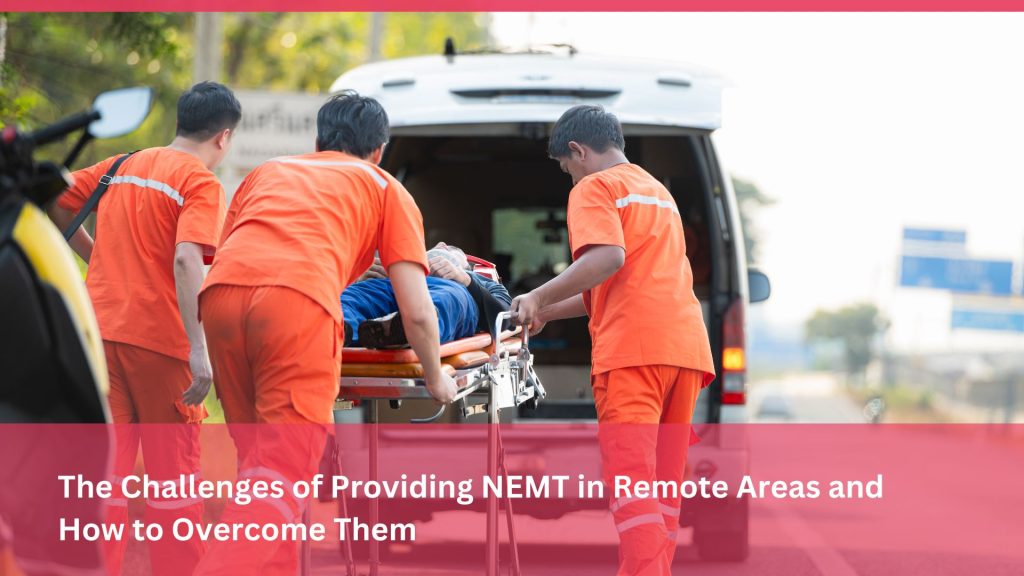New at Safr Care
The Challenges of Providing NEMT in Remote Areas and How to Overcome Them

The Challenges of Providing NEMT in Remote Areas and How to Overcome Them
Non-Emergency Medical Transportation (NEMT) services are crucial for patients who face barriers traveling to and from healthcare facilities. However, delivering these services in remote or rural regions introduces unique obstacles—such as vast distances, limited infrastructure, and sparse populations. Overcoming these challenges is essential to ensure equitable healthcare access for everyone, regardless of geographic location. This article examines the specific hurdles of providing NEMT in remote areas and offers strategies to address them effectively.
1. Limited Infrastructure and Long Distances
Rural and remote areas often lack the roads, public transit routes, and robust healthcare networks found in urban settings. Patients may live many miles from the nearest clinic, leading to:
- Extended Travel Times: Long trips can be tiring for patients with chronic conditions or mobility issues.
- Increased Operating Costs: Fuel consumption, vehicle wear and tear, and driver hours all rise with distance.
- Unpredictable Road Conditions: Weather, unpaved roads, and limited maintenance can further complicate travel.
Potential Solutions:
- Route Optimization Software: Tools that help plan efficient routes minimize both time and expense.
- Satellite or GPS Mapping: Real-time tracking and updates on road conditions ensure drivers can adjust as needed.
- Regional Coordination: Collaborating with nearby healthcare facilities to centralize appointments or share resources cuts down on repetitive long hauls.
2. Sparse Populations and Lower Demand
In remote areas, fewer patients may require rides on any given day, making it challenging to justify regular or frequent NEMT routes. This lower demand can lead to:
- Lower Profit Margins: Fewer trips can mean inconsistent revenues for NEMT providers.
- Limited Availability: Service gaps may arise, leaving some patients without transportation on certain days or at specific times.
- Higher Cost Per Trip: Without economies of scale, each ride becomes more expensive to operate.
Potential Solutions:
- Flexible Scheduling Models: Grouping appointments or employing on-demand services can raise the efficiency of each trip.
- Public-Private Partnerships: Cooperative funding and planning with local governments or transit agencies can fill service gaps.
- Community Outreach: Engaging residents to identify peak travel times or potential ride-sharing among patients can boost utilization.
3. Workforce Shortages and Driver Retention
Attracting and retaining skilled drivers in remote regions can be difficult. Long-distance routes, limited amenities, and competitive wages elsewhere can deter potential employees. This challenge leads to:
- Inconsistent Service: Driver shortages may force providers to reduce hours or cancel rides.
- Long Wait Times: Fewer drivers covering large territories can delay pickups and drop-offs.
- Higher Turnover: Frequent driver changes disrupt the continuity of care and rapport with patients.
Potential Solutions:
- Incentive Programs: Offering competitive wages, bonuses, or flexible schedules can attract and retain drivers.
- Local Recruitment and Training: Hiring from within the community fosters driver loyalty and familiarity with the area.
- Cross-Training Staff: Equipping drivers with basic patient care skills enhances their role and job satisfaction.
4. Funding and Insurance Complexities
NEMT providers often rely on reimbursements from Medicaid or private insurers, which can be lower or more complex in remote areas. Challenges include:
- Limited Medicaid Rates: Reimbursement may not fully cover the higher operational costs of rural routes.
- Bureaucratic Hurdles: Navigating diverse payer requirements adds administrative strain, particularly for smaller providers.
- Unstable Funding Streams: Budget cuts or policy changes can threaten the longevity of NEMT services.
Potential Solutions:
- Advocacy and Policy Support: Engaging legislators and local government to adjust reimbursement rates or implement subsidies for rural providers.
- Collaboration with Health Plans: Working with insurers to develop streamlined billing and fair compensation models.
- Grant Opportunities: Seeking grants and community funding specifically aimed at enhancing rural medical transportation.
5. Technology and Connectivity Gaps
Digital tools, such as scheduling apps and route optimization software, can greatly enhance NEMT efficiency. However, remote regions may struggle with limited internet connectivity or cellular coverage, hindering these innovations. Consequences include:
- Lack of Real-Time Coordination: Drivers can’t easily communicate changes or receive routing updates.
- Manual Scheduling: Without automated systems, providers may rely on time-consuming, error-prone paper processes.
- Reduced Patient Engagement: Patients may find it harder to track ride statuses or get timely updates via text or apps.
Potential Solutions:
- Offline-Friendly Software: Systems that function even with spotty service, updating when connections resume.
- Satellite Phones or Radios: Providing drivers with robust communication devices for critical route updates.
- Community Wi-Fi Hotspots: Partnering with local libraries, centers, or schools to establish scheduling and dispatch hubs.
Collaborating for Sustainable Solutions
Addressing these challenges requires a collective approach from healthcare organizations, local governments, insurers, and NEMT providers. By pooling resources and expertise, these stakeholders can:
- Share Data and Best Practices: Identifying regional trends and adapting proven solutions to remote contexts.
- Develop Coordinated Networks: Linking multiple facilities and community programs to streamline patient referrals and transport routes.
- Pursue Legislative Reforms: Advocating for policies that recognize higher rural transport costs and offer equitable reimbursement rates.
These collaborations help sustain and expand NEMT services, ensuring patients in remote areas receive the consistent care they deserve.
Conclusion
Providing NEMT services in remote areas is not without its hurdles, from vast distances and workforce shortages to connectivity and funding difficulties. Nonetheless, implementing strategic measures—like advanced route planning, shared resources, community outreach, and policy advocacy—can help providers overcome these barriers. When successful, NEMT transforms healthcare access in rural regions, reducing missed appointments, promoting preventive care, and improving long-term outcomes.
As healthcare continues to emphasize inclusivity and patient-centered strategies, bridging the transportation gap in remote communities remains crucial. With innovation, collaboration, and a commitment to serving all patients, NEMT providers can ensure that geographic isolation does not stand in the way of quality medical care for those who need it most.
